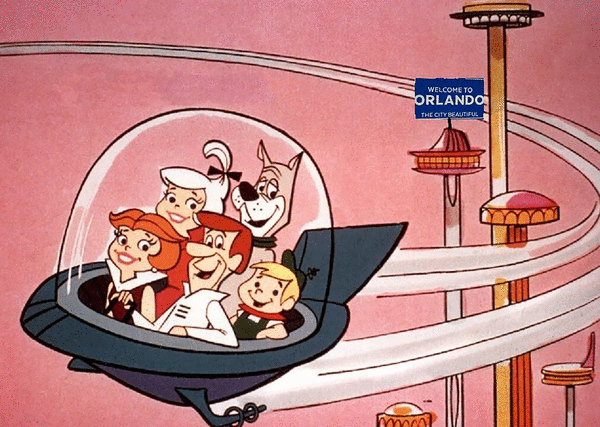Orlando could start to resemble 'The Jetsons' with flying cars from airport site as soon as 2028

ORLANDO, Fla. — Like something you’d see in the utopian future of TV’s “The Jetsons,” Orlando International Airport is trying to realize a long-desired dream of bringing flying cars to the region.
The Greater Orlando Aviation Authority on Wednesday took steps toward that future by seeking partners to develop and operate a flying car landing pad — called a vertiport — at the airport. The invitation is expected to publish in March with a 2028 target for a finished product.
The airport expects to put the vertiport on land in the East Airfield region on the northeast side or land on the south side near the train station, according to a news release.
Airport spokesperson Angela Starke said by email that inviting partners will help the airport gather information such as costs to build the vertiport. At present the aviation authority has no budget for the project.
Orlando Mayor Buddy Dyer, a member of the aviation authority, said the city is a global leader in Advanced Air Mobility (AAM) — the technology behind flying cars — and having the hub at the airport makes sense.
“We envision the airport to be a multimodal hub of the future,” Dyer said. “That means expanding the SunRail to the airport, Brightline from there to Tampa and making sure we have readied the airport as a vertihub of the future.”
He said vertiports may help manage the city’s growth, but that’s much farther off. He envisions starting with a four- to six-passenger vehicle operating out of the airport and eventually corridors for flying cars will follow. The small aircraft are expected to use electric power, and take off and land vertically.
“You can’t just have a vertiport at the airport, you have to have places for the vehicles to go from the airport to downtown Orlando or Tampa,” Dyer said. “I think before we see ‘The Jetsons’ this is going to be developed slowly.”
But not too slowly, if the mayor has his way.
After the first vertiport is established at the airport in three years, he said another in the downtown area is a real possibility soon after. Eventually he hopes to have a manufacturing facility in the city as well.
For years Orlando has been working to become the nation’s first city with a vertiport — but previous attempts haven’t taken flight.
A contract announced in 2020 between German flying car company Lilium Air Mobility and Lake Nona developer Tavistock ended before fulfilling its promise to have vehicles in Orlando by 2025. In 2021, Orlando partnered with NASA to establish a plan for how advanced air mobility could potentially be integrated into the city, but excitement died down over three years and nothing moved forward.
It wasn’t until 2024 that the idea was again propelled forward by key players including the Federal Aviation Administration. In February of that year, Lilium announced it was interested in establishing a vertiport hub at the airport.
While Lilium doesn’t have a contract with the airport yet, Starke said by email the announcement of negotiations for a vertiport hub may move the project along. She said the airport is working alongside the FAA.
In October, the FAA took a critical step forward when it issued a final rule for qualifications and training for AAM pilots and instructors. Then in November, the airport hosted a two-day tabletop exercise sponsored by the FAA focused on operating rules, aircraft certification and more.
Dyer said the one thing that could slow down progress is the FAA.
“A lot of the timing hinges on the development of rules and regulations by the FAA,” he said. “They’re responsible for things like developing routes or how they integrate with traffic control systems that we already have at airports so there’s a lot going into it before we have ‘The Jetsons’ flying around.”
Outside of Orlando, vertiports and flying vehicles are finding support, as well.
Earlier this month Jared Perdue, secretary of the Florida Department of Transportation, expressed his backing for advanced air mobility, which would involve establishing vertiports in urban areas that could serve as hubs for short aerial commutes by battery-powered aircraft that have characteristics of airplanes and helicopters.
And a bill filed in January by state Sen. Gayle Harrel, R-Stuart, would provide sales tax exemptions on the sale or lease of electric vertical takeoff and landing aircraft or flying cars.
----------
©2025 Orlando Sentinel. Visit at orlandosentinel.com. Distributed by Tribune Content Agency, LLC.